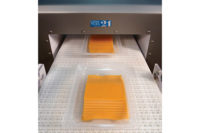Besides protecting dairy foods and beverages, flexible packaging affects pallet building, transportation and warehouse efficiencies. Two industry experts share the sustainability story of these materials.
Dairy processors are looking for flexible packaging that can solve a number of issues, including sustainability and cost effectiveness. We asked Chip Halverson, senior customer business manager for Scholle Packaging, Northlake, Ill., and Scott Bossong, director of dairy marketing for Sealed Air’s Cryovac, Elmwood Park, N.J., to discuss flexible packaging and what’s on the horizon.
Dairy Foods: What do dairy processors ask you about flexible packaging? What’s on their mind?
Bossong: Processors are always asking about convenience and if there are packaging solutions that can easily be implemented to set their products apart [with convenience features like easy-to-open and re-closable packages].
We’re getting questions from dairy processors about sustainable packaging solutions. As a result, we are continuously working on down-gauging our flexible packaging materials and consulting with our customers to make sure they are efficiently packaging their products. By using bags that are the appropriate size, processors can reduce wasted flexible packaging materials from bags that are too large.
Dairy Foods: What are dairy processors demanding from flexible packaging?
Halverson: Our dairy processor customers are looking for packaging that meets their sustainability goals to reduce landfill use and minimize the energy they spend in delivering their finished goods to the marketplace. They are also looking for solutions that provide benefits and efficiencies to aseptic processing and dispensing.
Bossong: Dairy processors are demanding flexible packaging solutions that can enhance plant efficiencies during the packing process and that are reliable throughout the transportation, distribution and retail processes.
Dairy Foods: What types of packaging have you developed or are you developing in response to these demands?
Halverson: With our low-acid aseptic packaging and filling equipment, we are able to help deliver a healthier, preservative-free option with a longer shelf life. Bag-in-box solutions also reduce energy in their creation compared to rigid packaging formats. That, along with product waste and landfill minimization, seems to be filling our customers’ demands.
Scholle has also developed a more-convenient way to connect aseptic bag-in-box packaged products to dispensing equipment with the QuickSeal Sentry SafeLock. This tamper-evident fitment provides a quick connection option that enhances food safety and reduces time in dispenser cleaning operations.
Bossong: The Cryovac Multi-Seal FoldLOK package for shredded and cubed cheeses addresses the demand for consumer convenience, improved plant efficiencies and reduced materials. Dairy processors can appreciate that the package runs on existing equipment with minimal alterations and results in a 2 inches or more reduction in packaging materials in most cases.
Cryovac Grip & Tear bags are designed to allow the consumer to easily open the bag by pulling on a tab. This easy-open line also features the Portion Pull bag with multiple tabs so the package is removed one strip at a time, keeping unused portions of the product fresh for longer. This is an ideal application behind the deli counter, as it greatly reduces cheese exposure to discoloration.
[Our] taped bag loader system brings an optimized level of versatility and efficiency to automated bag loading. Addressing the demand for improved plant efficiencies, the system allows processors to program their in-feed for both in-line and perpendicular product separation and staging, depending on the application.
[We have] a powerful combination of hardware, software, equipment and services that provide the ability to measure, control and improve both processes and costs associated with processors’ packaging lines. This system yields improved plant efficiencies by permitting packaging line information to be gathered, sorted and effectively used for the benefit of the overall operation.
Dairy Foods: Describe a good-better-best approach to packaging of cheese.
Bossong: Good: auto-loading into a bag and manual vacuum loading machinery. Better: semi-automatic bag loader, which you push in manually. Best: automated cutting, loading of the products into the package and vacuuming of the product followed by automatic labeling, case erection, and palletization. The most efficient packaging solution would eliminate handling at as many touch-points in the packaging process as possible.
Dairy Foods: Everyone in the industry is looking at sustainability. Explain how your packaging can help a processor reduce its carbon footprint.
Halverson: Bag-in-box packaging has some inherent sustainable traits; it uses less raw material and energy during manufacturing when compared to rigid packaging that holds equal volumes of product. Logistically speaking, benefits include more efficient transportation and pallet utilization leading to space efficiencies at warehouses and at the final destination because our packaging cubes out so well. You’re not shipping air at any point. At the post-consumer stage, Scholle bag-in-box results in less landfill waste when compared to rigid containers holding equal volumes of product.
Bossong: Reducing food waste through our high-performing packaging materials is a large part of our sustainability approach, as food waste can have 10 times the environmental impact of packaging, according to a study from the International Packaging Institute in 2008. Also, wasted food releases methane in landfills, which is 25 times more damaging to the environment than carbon dioxide. We actively reduce food waste by providing longer shelf and quality lives for our customers’ products and reducing the amount of wasted product resulting from compromised, damaged or opened packaging.
Reducing materials can reduce carbon footprint as well. For example, [our] Multi-Seal FoldLOK package takes a minimum of an inch off of most re-closable shredded cheese packaging (2 inches in web width) by removing the zipper, which not only reduces materials used but ultimately allows for more product to fit into a box, more boxes to fit on a pallet and more pallets to fit on a truck. This ultimately results in less corrugated materials, more products per pallet and truck, reducing the number of hauls over time and resulting in a smaller carbon footprint.
Dairy Foods: What changes in the dairy industry have affected your business in the last year or two?
Bossong: We continue to see huge growth in the specialty cheese market as consumers (especially baby boomers) continue to be exposed to new varieties of cheeses. Retailers see this as a profitable dairy niche and are looking to differentiate these products through packaging designs that feature premium graphics that stand out in the case. As the dairy industry continues to consolidate, there is an increased push for fast and reliable package processes that reduce product rejects and downtime on the automated lines.
Dairy Foods: What’s next for flexible packaging in the dairy industry?
Halverson: Portion control and dispensing technology is the next big thing in the dairy industry. Moving towards a portion-controlled dispensing solution instead of individual packages will reduce product and energy waste while cutting costs. The packaging company that can innovate and produce aseptic fitments and connectors that integrate easily into dispensing systems will most certainly have an in-demand set of solutions for the dairy industry.
Bossong: We will continue to see an effort to make flexible packaging as convenient for consumers as possible and increased integration of automated packaging systems and solutions at the processor level.
Edited by Sarah Kennedy, associate editor.



